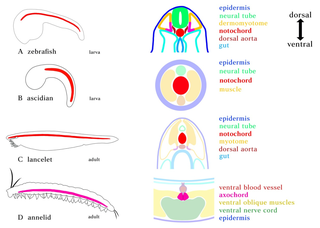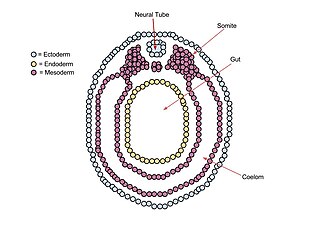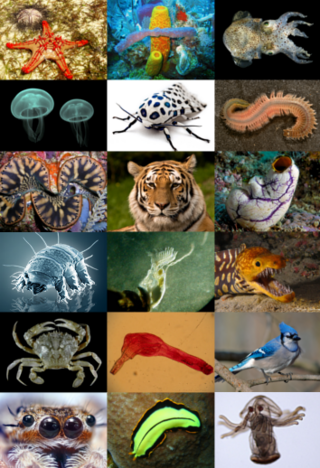Related Research Articles

Ontogeny is the origination and development of an organism, usually from the time of fertilization of the egg to adult. The term can also be used to refer to the study of the entirety of an organism's lifespan.

The mesoderm is the middle layer of the three germ layers that develops during gastrulation in the very early development of the embryo of most animals. The outer layer is the ectoderm, and the inner layer is the endoderm.

In zoology and developmental anatomy, the notochord is an elastic, rod-like anatomical structure found in many deuterostomal animals. A notochord is one of five synapomorphies used to define a species as a chordate.

The somites are a set of bilaterally paired blocks of paraxial mesoderm that form in the embryonic stage of somitogenesis, along the head-to-tail axis in segmented animals. In vertebrates, somites subdivide into the dermatomes, myotomes, sclerotomes and syndetomes that give rise to the vertebrae of the vertebral column, rib cage, part of the occipital bone, skeletal muscle, cartilage, tendons, and skin.
A germ layer is a primary layer of cells that forms during embryonic development. The three germ layers in vertebrates are particularly pronounced; however, all eumetazoans produce two or three primary germ layers. Some animals, like cnidarians, produce two germ layers making them diploblastic. Other animals such as bilaterians produce a third layer between these two layers, making them triploblastic. Germ layers eventually give rise to all of an animal's tissues and organs through the process of organogenesis.

Cephalization is an evolutionary trend in animals that, over many generations, the special sense organs and nerve ganglia become concentrated towards the rostral end of the body where the mouth is located, often producing an enlarged head. This is associated with the animal's movement direction and bilateral symmetry, and cephalization of the nervous system led to the formation of a functional centralized brain in three groups of bilaterian animals, namely the arthropods, cephalopod molluscs, and vertebrates (craniates).

A neurula is a vertebrate embryo at the early stage of development in which neurulation occurs. The neurula stage is preceded by the gastrula stage; consequentially, neurulation is preceded by gastrulation. Neurulation marks the beginning of the process of organogenesis.

Pharyngeal slits are filter-feeding organs found among deuterostomes. Pharyngeal slits are repeated openings that appear along the pharynx caudal to the mouth. With this position, they allow for the movement of water in the mouth and out the pharyngeal slits. It is postulated that this is how pharyngeal slits first assisted in filter-feeding, and later, with the addition of gills along their walls, aided in respiration of aquatic chordates. These repeated segments are controlled by similar developmental mechanisms. Some hemichordate species can have as many as 200 gill slits. Pharyngeal clefts resembling gill slits are transiently present during the embryonic stages of tetrapod development. The presence of pharyngeal arches and clefts in the neck of the developing human embryo famously led Ernst Haeckel to postulate that "ontogeny recapitulates phylogeny"; this hypothesis, while false, contains elements of truth, as explored by Stephen Jay Gould in Ontogeny and Phylogeny. However, it is now accepted that it is the vertebrate pharyngeal pouches and not the neck slits that are homologous to the pharyngeal slits of invertebrate chordates. Pharyngeal arches, pouches, and clefts are, at some stage of life, found in all chordates. One theory of their origin is the fusion of nephridia which opened both on the outside and the gut, creating openings between the gut and the environment.

Neural crest cells are a temporary group of cells that arise from the embryonic ectoderm germ layer, and in turn give rise to a diverse cell lineage—including melanocytes, craniofacial cartilage and bone, smooth muscle, peripheral and enteric neurons and glia.

The pharyngeal arches, also known as visceral arches, are structures seen in the embryonic development of vertebrates that are recognisable precursors for many structures. In fish, the arches are known as the branchial arches, or gill arches.

A body plan, Bauplan, or ground plan is a set of morphological features common to many members of a phylum of animals. The vertebrates share one body plan, while invertebrates have many.

Paraxial mesoderm, also known as presomitic or somitic mesoderm, is the area of mesoderm in the neurulating embryo that flanks and forms simultaneously with the neural tube. The cells of this region give rise to somites, blocks of tissue running along both sides of the neural tube, which form muscle and the tissues of the back, including connective tissue and the dermis.

Mesenchyme is a type of loosely organized animal embryonic connective tissue of undifferentiated cells that give rise to most tissues, such as skin, blood or bone. The interactions between mesenchyme and epithelium help to form nearly every organ in the developing embryo.

Limb development in vertebrates is an area of active research in both developmental and evolutionary biology, with much of the latter work focused on the transition from fin to limb.

Gerd B. Müller is an Austrian biologist who is emeritus professor at the University of Vienna where he was the head of the Department of Theoretical Biology in the Center for Organismal Systems Biology. His research interests focus on vertebrate limb development, evolutionary novelties, evo-devo theory, and the Extended Evolutionary Synthesis. He is also concerned with the development of 3D based imaging tools in developmental biology.

Osteochondroprogenitor cells are progenitor cells that arise from mesenchymal stem cells (MSC) in the bone marrow. They have the ability to differentiate into osteoblasts or chondrocytes depending on the signalling molecules they are exposed to, giving rise to either bone or cartilage respectively. Osteochondroprogenitor cells are important for bone formation and maintenance.

Trabecular cartilages are paired, rod-shaped cartilages, which develop in the head of the vertebrate embryo. They are the primordia of the anterior part of the cranial base, and are derived from the cranial neural crest cells.
Segmentation is the physical characteristic by which the human body is divided into repeating subunits called segments arranged along a longitudinal axis. In humans, the segmentation characteristic observed in the nervous system is of biological and evolutionary significance. Segmentation is a crucial developmental process involved in the patterning and segregation of groups of cells with different features, generating regional properties for such cell groups and organizing them both within the tissues as well as along the embryonic axis.
Scott Frederick Gilbert is an American evolutionary developmental biologist and historian of biology.

Carole LaBonne is a Developmental and Stem Cell Biologist at Northwestern University. She is the Erastus O. Haven Professor of Life Sciences, and Chair of the Department of Molecular Biosciences.
References
- ↑ Angier, Natalie (31 May 1995). "Modern 'Wolfmen' May Have Inherited Ancient Gene". The New York Times. p. 10. Retrieved 20 August 2011.
- ↑ "Dr. Brian Hall". Dalhousie University . Retrieved 20 August 2011.
- ↑ Somers, Mary (February 13, 2002). "Biologist wins the Kowalevsky Medal". Internet Archive . Dalhousie University. Archived from the original on September 25, 2006. Retrieved 20 August 2011.
- 1 2 3 4 5 "Brian K. Hall". The Embryo Project Encyclopedia.
- 1 2 Hall, Brian K; Hallgrimsson, Benedikt (2014), Strickberger's Evolution (5th ed.), Burlington, MA: Jones & Bartlett Learning, ISBN 978-1-4496-1484-3 , retrieved 21 July 2014
- ↑ Brian K. Hall's faculty profile, Halifax, Nova Scotia: Dalhousie University, Department of Biology, retrieved 22 July 2014
- ↑ MacLean, Norman; Hall, Brian Keith (1987-08-13). Cell Commitment and Differentiation . CUP Archive. ISBN 9780521308847.
- ↑ Hall, Brian K. (1999-07-30). The Neutral Crest in Development and Evolution. ISBN 9780387987026.
- ↑ Hall, Brian K.; Wake, Marvalee H. (1999-01-12). The Origin and Evolution of Larval Forms. ISBN 9780127309354.
- ↑ "Department of Biology".
- ↑ Hallgrímsson, Benedikt; Hall, Brian K. (2011-05-04). Variation. ISBN 9780080454467.
- ↑ Hallgrâimsson, Benedikt; Hall, Brian Keith (2005). A Central Concept Biology. ISBN 978-0120887774.
- ↑ "Dr. Brian K. Hall". Dalhousie University.
- ↑ Love, Arthur C (September 2007), "Putting the Pieces Together", Science, 317 (5844): 1502–1503, doi:10.1126/science.1145812, S2CID 220084887 , retrieved 22 July 2014
- ↑ Hall, Brian K. (2007-02-01). Fins into Limbs: Development Transformation. ISBN 978-0226313375.
- ↑ Benedikt Hallgrimsson Ph, D.; Brian, K.D. (2011-04-11). Epigenetics. ISBN 9780520948822.
- ↑ Badyaev, Alexander V. (March 2013). "Review: Defining Epigenetics in Deterministic Terms" (PDF). BioScience. 63 (3): 224–227. doi: 10.1525/bio.2013.63.3.11 . JSTOR 10.1525/bio.2013.63.3.11.